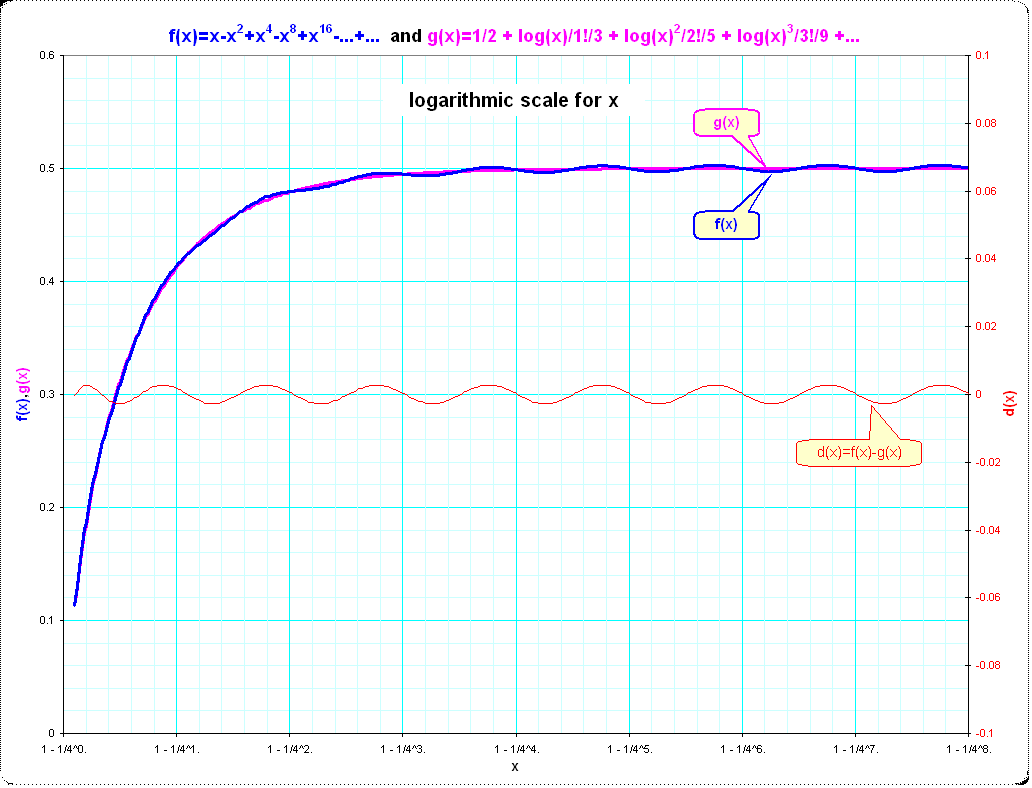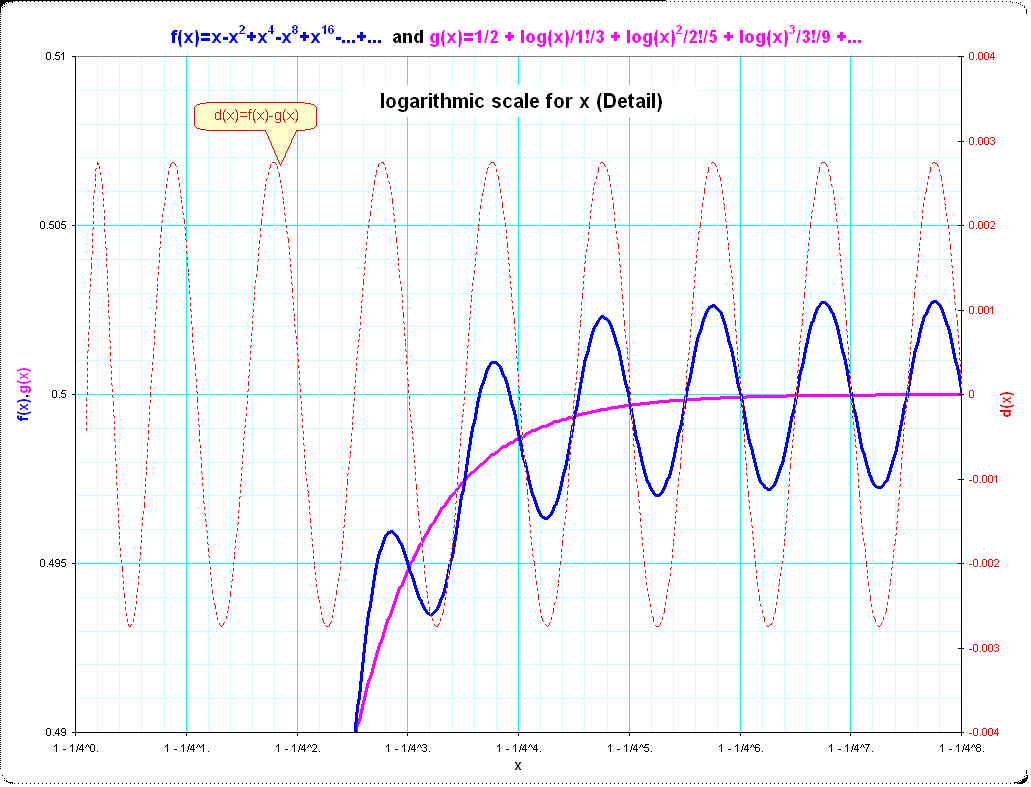This is more an extended comment than an answer.
I refer to your function
$$ f(x) = \sum_{k=0}^\infty (-1)^k x^{2^k} \qquad \qquad 0 \lt x \lt 1 \tag 1$$ and as generalization
$$ f_b(x)= \sum_{k=0}^\infty (-1)^k x^{b^k} \qquad \qquad 1 \lt b \tag 2$$
[update 8'2016] The same values as for the function $g(x)$ as described below one gets seemingly simply by the completing function of $f(x)$ -the sum where the index goes to negative infinity, such that, using Cesarosummation $\mathfrak C$ for the alternating divergent series in $h(x)$ , we have that
$$h(x) \underset{\mathfrak C}=\sum_{k=1}^\infty (-1)^k x^{2^{-k}} \qquad \qquad \underset{\text{apparently } }{=} -g(x) \tag{2.1} $$
(Note, the index starts at $1$) .
The difference-curve $d(x)$ as shown in the pictures of my original answer below occurs then similarly by
$$d(x)= h(x)+f(x) \underset{\mathfrak C}= \sum_{k=-\infty}^\infty (-1)^k x^{2^k} \tag {2.2}$$
Using the derivation provided in @Zurab Silagadze's answer I get the alternative description (using the constants $l_2=\log(2)$ and $\rho = \pi i/l_2$ )
$$ d^*(x) \underset{
\lambda=\log(1/x) \\
\tau = \lambda^\rho}{=} \quad {2\over l_2 } \sum_{\begin{matrix}k=0 \\ j=2k+1 \end{matrix}}^\infty \Re\left[{\Gamma( \rho \cdot j ) \over \tau^j}\right] \tag {2.3}$$
which agrees numerically very well with the direct computation of $d(x)$.
(I don't have yet a guess about the relevance of this, though, and whether $d(x)$ has also some other, especially closed form, representation)
[end update]
To get possibly more insight into the nature of the "wobbling" I also looked at the (naive) expansion into double-series.
By writing $u=\ln(x)$ and expansion of the powers of $x$ into exponential-series we get the following table:
$$ \small \begin{array} {r|rr|rrrrrrrrrrrrrr}
+x & & +\exp(u) &&= +(& 1&+u&+u^2/2!&+u^3/3!&+...&) \\
-x^2 & & -\exp(2u)& &= -(& 1&+2u&+2^2u^2/2!&+2^3u^3/3!&+...&) \\
+x^4 & & +\exp(4u)& &= +(& 1&+4u&+4^2u^2/2!&+4^3u^3/3!&+...&) \\
-x^8 & & -\exp(8u)& &= -(& 1&+8u&+8^2u^2/2!&+8^3u^3/3!&+...&) \\
\vdots & & \vdots & \\ \hline
f(x) & & ??? &g(x) &=( & 1/2 & +{1 \over1+2} u &+{1 \over1+2^2} {u^2 \over 2!} &+{1 \over1+2^3} {u^3 \over 3!} & +... &)
\end{array}$$
where $g(x)$ is computed using the closed forms of the alternating geometric series along the columns.
The naive expectation is, that $f(x)=g(x)$ but which is not true. However, $$g(x)=\sum_{k=0}^\infty {(\ln x)^k\over (1+2^k) k! } \tag 3 $$ is still a meaningful construct: it defines somehow a monotonuous increasing "core-function" for the wobbly function $f(x)$ , perhaps so to say a functional "center of gravity".
The difference $$d(x)=f(x)-g(x) \tag 4$$
captures then perfectly the oscillatory aspect of $f(x)$. Its most interesting property is perhaps, that it seems to have perfectly constant amplitude ($a \approx 0.00274922$) . The wavelength however is variable and well described by the transformed value $x=1-4^{-y}$ as already stated by others. With this transformation the wavelength approximates $1$ very fast and very well for variable $y$.
For the generalizations $f_b(x)$ with $b \ne 2$ the amplitude increases with $b$, for instance for $b=4$ we get the amplitude $A \approx 0.068$ and for $b=2^{0.25}$ is $a \approx 3e-12$
Here are pictures of the function $f(x)$, $g(x)$ and $d(x)= f(x)-g(x)$ :

The blue line and the magenta line are nicely overlaid over the whole range $0<x<1$ and the amplitude of the red error-curve (the $y$-scale is at the right side) seems to be constant.
In the next picture I rescaled also the x-axis logarithmically (I've used the hint from Robert Israel's anwer to apply the exponentials to base $4$):

Having the x-axis a logarithmic scale, the curve of the $d(x)$ looks like a perfect sine-wave (with a slight shift in wave-length). If this is true, then because $g(0)=1/2$ the non-vanishing oscillation of $f(x)$, focused in the OP, when $x \to 1$ is obvious because it's just the oscillation of the $d(x)$-curve...
For the more critical range near $y=0.5$ I've a zoomed picture for this:

But from here my expertise is exhausted and I've no tools to proceed. First thing would be to look at the Fourier-decomposition of $d(x)$ which might be simpler than that of $f(x)$. Possibly we have here something like in the Ramanujan-summation of divergent series where we have to add some integral to complete the divergent sums, but I really don't know.





